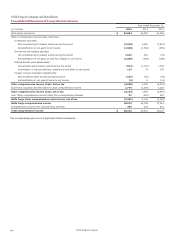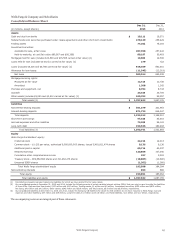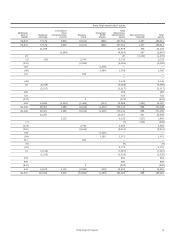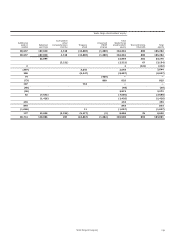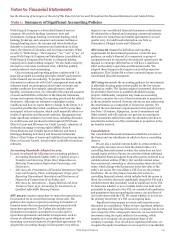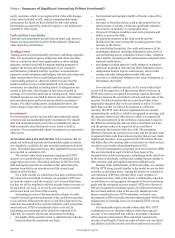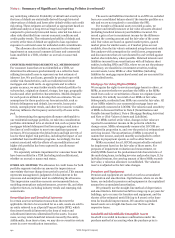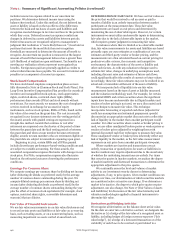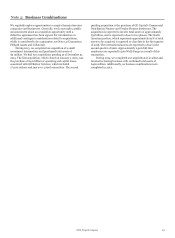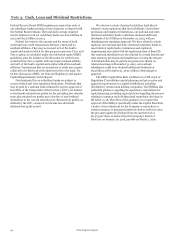Wells Fargo 2015 Annual Report Download - page 145
Download and view the complete annual report
Please find page 145 of the 2015 Wells Fargo annual report below. You can navigate through the pages in the report by either clicking on the pages listed below, or by using the keyword search tool below to find specific information within the annual report.fair value of the security, and the investee's financial condition,
capital strength, and near-term prospects.
We recognize realized gains and losses on the sale of
investment securities in noninterest income using the specific
identification method.
Unamortized premiums and discounts are recognized in
interest income over the contractual life of the security using the
interest method. As principal repayments are received on
securities (i.e., primarily mortgage-backed securities (MBS)) a
proportionate amount of the related premium or discount is
recognized in income so that the effective interest rate on the
remaining portion of the security continues unchanged.
HELD-TO-MATURITY SECURITIES Debt securities for which
the Company has the positive intent and ability to hold to
maturity are reported at historical cost adjusted for amortization
of premiums and accretion of discounts. We recognize OTTI
when there is a decline in fair value and we do not expect to
recover the entire amortized cost basis of the debt security. The
amortized cost is written-down to fair value with the credit loss
component recorded to earnings and the remaining component
recognized in OCI. The OTTI assessment related to whether we
expect recovery of the amortized cost basis and determination of
any credit loss component recognized in earnings for held-to-
maturity securities is the same as described for available-for-sale
securities. Security transfers to the held-to-maturity
classification are recorded at fair value. Unrealized gains or
losses from the transfer of available-for-sale securities continue
to be reported in cumulative OCI and are amortized into
earnings over the remaining life of the security using the
effective interest method.
NONMARKETABLE EQUITY INVESTMENTS Nonmarketable
equity investments include low income housing tax credit
investments, equity securities that are not publicly traded and
securities acquired for various purposes, such as to meet
regulatory requirements (for example, Federal Reserve Bank and
Federal Home Loan Bank (FHLB) stock). We have elected the
fair value option for some of these investments with the
remainder of these investments accounted for under the cost or
equity method, which we review at least quarterly for possible
OTTI. Our review typically includes an analysis of the facts and
circumstances of each investment, the expectations for the
investment's cash flows and capital needs, the viability of its
business model and our exit strategy. We reduce the asset value
when we consider declines in value to be other than temporary.
We recognize the estimated loss as a loss from equity
investments in noninterest income.
Securities Purchased and Sold Agreements
Securities purchased under resale agreements and securities sold
under repurchase agreements are accounted for as collateralized
financing transactions and are recorded at the acquisition or sale
price plus accrued interest. We monitor the fair value of
securities purchased and sold and obtain collateral from or
return it to counterparties when appropriate. These financing
transactions do not create material credit risk given the
collateral provided and the related monitoring process.
Mortgages and Loans Held for Sale
Mortgages held for sale (MHFS) include commercial and
residential mortgages originated for sale and securitization in
the secondary market, which is our principal market, or for sale
as whole loans. We have elected the fair value option for
substantially all residential MHFS (see Note 17 (Fair Values of
Assets and Liabilities)). The remaining residential MHFS are
held at the lower of cost or fair value (LOCOM) and are valued
on an aggregate portfolio basis. Commercial MHFS are held at
LOCOM and are valued on an individual loan basis.
Loans held for sale (LHFS) are carried at LOCOM.
Generally, consumer loans are valued on an aggregate portfolio
basis, and commercial loans are valued on an individual loan
basis.
Gains and losses on MHFS are recorded in mortgage
banking noninterest income. Gains and losses on LHFS are
recorded in other noninterest income. Direct loan origination
costs and fees for MHFS and LHFS under the fair value option
are recognized in income at origination. For MHFS and LHFS
recorded at LOCOM, loan costs and fees are deferred at
origination and are recognized in income at time of sale. Interest
income on MHFS and LHFS is calculated based upon the note
rate of the loan and is recorded to interest income.
Our lines of business are authorized to originate held-for-
investment loans that meet or exceed established loan product
profitability criteria, including minimum positive net interest
margin spreads in excess of funding costs. When a
determination is made at the time of commitment to originate
loans as held for investment, it is our intent to hold these loans
to maturity or for the “foreseeable future,” subject to periodic
review under our management evaluation processes, including
corporate asset/liability management. In determining the
“foreseeable future” for loans, management considers (1) the
current economic environment and market conditions, (2) our
business strategy and current business plans, (3) the nature and
type of the loan receivable, including its expected life, and (4)
our current financial condition and liquidity demands. If
subsequent changes, including changes in interest rates,
significantly impact the ongoing profitability of certain loan
products, we may subsequently change our intent to hold these
loans, and we would take actions to sell such loans. Upon such
management determination, we immediately transfer these
loans to the MHFS or LHFS portfolio at LOCOM.
Loans
Loans are reported at their outstanding principal balances net of
any unearned income, cumulative charge-offs, unamortized
deferred fees and costs on originated loans and unamortized
premiums or discounts on purchased loans. PCI loans are
reported net of any remaining purchase accounting adjustments.
See the “Purchased Credit-Impaired Loans” section in this Note
for our accounting policy for PCI loans.
Unearned income, deferred fees and costs, and discounts
and premiums are amortized to interest income over the
contractual life of the loan using the interest method. Loan
commitment fees are generally deferred and amortized into
noninterest income on a straight-line basis over the commitment
period.
We have certain private label and co-brand credit card loans
through a program agreement that involves our active
participation in the operating activity of the program with a third
party. We share in the economic results of the loans subject to
this agreement. We consider the program to be a collaborative
arrangement and therefore report our share of revenue and
losses on a net basis in interest income for loans, other
noninterest income and provision for credit losses as applicable.
Our net share of revenue from this activity represented less than
1% of our total revenues for 2015.
Loans also include direct financing leases that are recorded
at the aggregate of minimum lease payments receivable plus the
estimated residual value of the leased property, less unearned
Wells Fargo & Company
143



